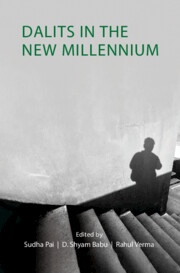Book contents
- Frontmatter
- Contents
- List of Figures
- List of Tables
- Acknowledgements
- 1 Introduction: Dalit Discourse in the New Millennium
- Part I Shifting Patterns of Electoral Politics
- Part II Popular Culture, Discourse, and Protest
- 7 Music as the Language of the Bahujan Movement: Locating the Social History of the Dalit Shoshit Samaj Sangharsh Samiti
- 8 Anti-Caste Music and Cinema
- 9 Portrayal of Dalits in the Media: A Study of Select Newspapers from Uttar Pradesh
- 10 Hierarchy in Protest: A Comparison of Dalit and Upper-Caste Agitations
- Part III Transformations in Ideology and Identity
- Part IV Aspirations and Anxieties
- Part V Discrimination and Representation
- About the Contributors
- Index
10 - Hierarchy in Protest: A Comparison of Dalit and Upper-Caste Agitations
from Part II - Popular Culture, Discourse, and Protest
Published online by Cambridge University Press: 12 July 2023
- Frontmatter
- Contents
- List of Figures
- List of Tables
- Acknowledgements
- 1 Introduction: Dalit Discourse in the New Millennium
- Part I Shifting Patterns of Electoral Politics
- Part II Popular Culture, Discourse, and Protest
- 7 Music as the Language of the Bahujan Movement: Locating the Social History of the Dalit Shoshit Samaj Sangharsh Samiti
- 8 Anti-Caste Music and Cinema
- 9 Portrayal of Dalits in the Media: A Study of Select Newspapers from Uttar Pradesh
- 10 Hierarchy in Protest: A Comparison of Dalit and Upper-Caste Agitations
- Part III Transformations in Ideology and Identity
- Part IV Aspirations and Anxieties
- Part V Discrimination and Representation
- About the Contributors
- Index
Summary
We live in a loktantra [democracy]. But once voting is over, we are forgotten. To be seen and heard in between elections, we have to remember a democracy is also a bheedtantra [system of crowds]. Where a crowd alarms the state, the state wakes up. It sees. It listens. That is why it is important to protest.
Unless a child cries, even a mother does not listen. Why will the state pay attention to the poor unless they protest?
Introduction
Protests mobilize citizens and represent collective action. They give voice to citizens by articulating their demands. They highlight salient concerns in the public domain. Protests are an increasingly popular form of representing grievances and aspirations across the world (The Economist, 2020). According to government data, India clocks more than 300 protests per day. And as the two testimonies in the epigraphs point out, citizens understand the significance of protest politics. This chapter focuses on the study of identity-based protests.
Identity is a popular focal point for protest mobilization because it can be a source of shared interests, grievances, and networks. But do all identity groups turn to identity-based protests to the same degree? Around the world, societies are defined by a variety of structural inequalities. In many instances, these are rooted in ethnic and racial identities. The social and political behaviour of marginalized groups is distinct and can differ from the politics of dominant groups. Still, we know little about how these differences manifest across a variety of forms of politics, including protest activity. For instance, how does the protest behaviour of Blacks compare with that of Whites in the United States and in South Africa, or the protests of indigenous communities compare with those of Whites across Latin America, or the protests of Dalits compare with those of upper castes in India?
In this chapter, we explore Dalit protest activity within the context of hierarchical caste group relations. Specifically, we ask, is the protest activity of Dalits (the lowest ranked group in the caste hierarchy) different from that of the upper castes (the highest ranked group)?
- Type
- Chapter
- Information
- Dalits in the New Millennium , pp. 166 - 190Publisher: Cambridge University PressPrint publication year: 2023

